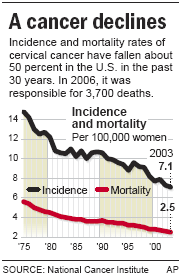
Here is a new vaccine for human papillomavirus or HPV. Take a look at one place you find this virus. It's a monkey virus. Coincidentally the same monkeys that were used to make the polio vaccine.
Med Citation
Articles by Wood, C. E.
Articles by Cline, J. M.
Vet Pathol 41:108-115 (2004)
© 2004 American College of Veterinary Pathologists
Cervical and Vaginal Epithelial Neoplasms in Cynomolgus Monkeys C. E. Wood, H. Borgerink, T. C. Register, L. Scott and J. M. Cline Comparative Medicine Clinical Research Center, Wake Forest University Health Sciences, Winston-Salem, NC
Papillomavirus-associated cervical cancer is the second most common neoplasm in women but has rarely been reported in animals. This report describes cervical and vaginal intraepithelial neoplasms identified in routine histologic specimens obtained from 20 (5.2%) of 385 female cynomolgus macaques (Macaca fascicularis) being used in long-term studies. Lesion incidence was similar in both control and hormonally treated animals (4.7% and 5.5%, respectively). Neoplasms included benign vaginal papillomas, mild to severe intraepithelial dysplasias, and two invasive cervical carcinomas. Common morphologic features included koilocytosis, nuclear atypia, and expansion of the basal epithelium. Selective staining of lesions with at least one of three papillomavirus antibodies was observed in all cases (20 of 20). In contrast, immunostaining of lesions was negative for Epstein-Barr–related virus proteins (0 of 20). The unique similarities between the observed lesions and those seen in women suggest that macaques may provide a suitable animal model for study of papillomavirus oncogenesis.
Key words: Cervical intraepithelial neoplasia; immunohistochemistry; Macaca fascicularis; nonhuman primates; papillomavirus.
Request reprints from Dr. C. E. Wood, Comparative Medicine Clinical Research Center, Wake Forest University Health Sciences, Medical Center Boulevard, Winston-Salem, NC 27157-1040 (USA). E-mail: chwood@wfubmc.edu.
The cynomolgus monkey is best known as the first clinical test animal for the development of the polio vaccine. They are involved in WNPRC studies of infectious disease, reproduction and other areas.
http://www.primate.wisc.edu/wprc/pdfs/Macaque.pdf
Med Citation
Articles by Wood, C. E.
Articles by Cline, J. M.
Vet Pathol 41:108-115 (2004)
© 2004 American College of Veterinary Pathologists
Cervical and Vaginal Epithelial Neoplasms in Cynomolgus Monkeys C. E. Wood, H. Borgerink, T. C. Register, L. Scott and J. M. Cline Comparative Medicine Clinical Research Center, Wake Forest University Health Sciences, Winston-Salem, NC
Papillomavirus-associated cervical cancer is the second most common neoplasm in women but has rarely been reported in animals. This report describes cervical and vaginal intraepithelial neoplasms identified in routine histologic specimens obtained from 20 (5.2%) of 385 female cynomolgus macaques (Macaca fascicularis) being used in long-term studies. Lesion incidence was similar in both control and hormonally treated animals (4.7% and 5.5%, respectively). Neoplasms included benign vaginal papillomas, mild to severe intraepithelial dysplasias, and two invasive cervical carcinomas. Common morphologic features included koilocytosis, nuclear atypia, and expansion of the basal epithelium. Selective staining of lesions with at least one of three papillomavirus antibodies was observed in all cases (20 of 20). In contrast, immunostaining of lesions was negative for Epstein-Barr–related virus proteins (0 of 20). The unique similarities between the observed lesions and those seen in women suggest that macaques may provide a suitable animal model for study of papillomavirus oncogenesis.
Key words: Cervical intraepithelial neoplasia; immunohistochemistry; Macaca fascicularis; nonhuman primates; papillomavirus.
Request reprints from Dr. C. E. Wood, Comparative Medicine Clinical Research Center, Wake Forest University Health Sciences, Medical Center Boulevard, Winston-Salem, NC 27157-1040 (USA). E-mail: chwood@wfubmc.edu.
The cynomolgus monkey is best known as the first clinical test animal for the development of the polio vaccine. They are involved in WNPRC studies of infectious disease, reproduction and other areas.
http://www.primate.wisc.edu/wprc/pdfs/Macaque.pdf

Do we really need this vaccine? Merck wants to make it a law we take it?
Updated: 4:52 p.m. ET Jan 30, 2007 AUSTIN, Texas - Merck & Co. is helping bankroll efforts to pass state laws requiring girls as young as 11 or 12 to receive the drugmaker’s new vaccine against the sexually transmitted cervical-cancer virus.
Cathie Adams, president of the conservative watchdog group Texas Eagle Forum, said the relationship between Merck and Women in Government is too cozy.
“What it does is benefit the pharmaceutical companies, and I don’t want pharmaceutical companies taking precedence over the authorities of parents,” she said.
http://www.msnbc.msn.com/id/16891832/ for the full story....
Updated: 4:52 p.m. ET Jan 30, 2007 AUSTIN, Texas - Merck & Co. is helping bankroll efforts to pass state laws requiring girls as young as 11 or 12 to receive the drugmaker’s new vaccine against the sexually transmitted cervical-cancer virus.
Cathie Adams, president of the conservative watchdog group Texas Eagle Forum, said the relationship between Merck and Women in Government is too cozy.
“What it does is benefit the pharmaceutical companies, and I don’t want pharmaceutical companies taking precedence over the authorities of parents,” she said.
http://www.msnbc.msn.com/id/16891832/ for the full story....
